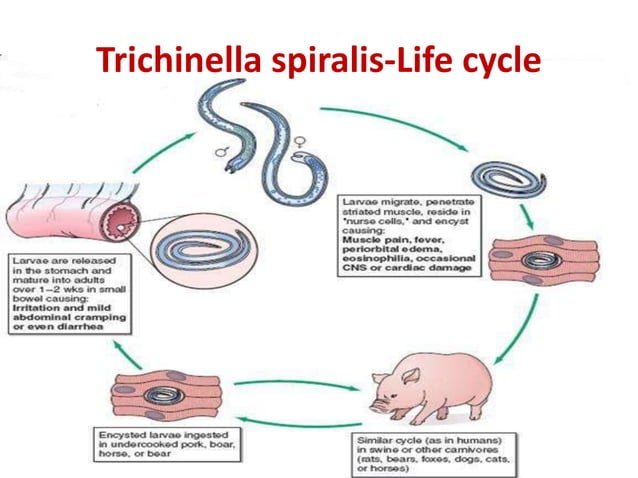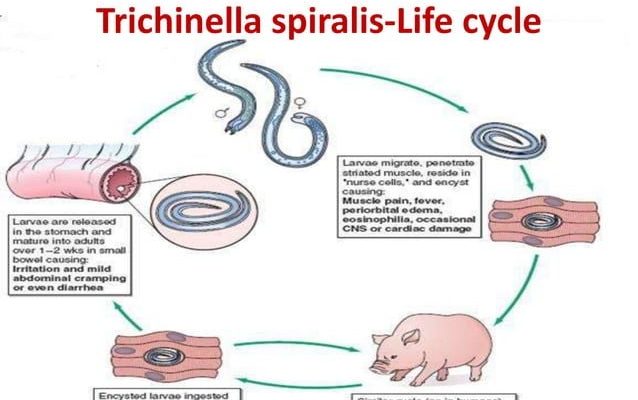
Trichinella spiralis doesn’t just live in isolation; it interacts with a wide variety of other microfauna in its environment. This interaction can lead to complex relationships that affect everything from host health to the broader ecosystem balance. Let’s dive into this tiny world and explore how Trichinella spiralis interacts with its microfauna neighbors, stepping through their ecosystems and relationships in a way that’s easy to understand.
Understanding Trichinella Spiralis
Trichinella spiralis is a small roundworm, usually just a couple of millimeters long, but don’t let its size fool you. This parasite can cause trichinosis, a disease that affects several mammals, including pigs, which are often its primary hosts. When humans eat undercooked pork infected with Trichinella cysts, they can also become unwitting hosts.
Once ingested, the larvae hatch in the intestines of the host. They then burrow into the muscle tissue, where they can live for years. This cycle creates a loop of interaction not only with the host but also with other microfauna that share its habitat. For example, these interactions can include competition for resources or triggering immune responses that alter the environment.
In a way, you can think of Trichinella spiralis as a piece of a puzzle in a much larger ecosystem. Its presence or absence can influence numerous other organisms, from other parasitic species to bacterial populations.
Microfauna: The Tiny Players in Ecosystems
Microfauna include a variety of minute organisms like protozoa, bacteria, and other tiny creatures that coexist in the same environments. They play essential roles in nutrient cycling, soil health, and even influencing larger species’ behaviors. For instance, bacteria can help decompose organic matter, while protozoa often feed on bacteria, keeping their populations in check.
Trichinella spiralis interacts with these microfauna in a way that’s both symbiotic and competitive. On one hand, it can rely on certain bacteria to aid its lifecycle, while on the other, it must compete with other parasites and microorganisms for resources. This creates a delicate balance within its ecosystem—too much Trichinella might disrupt this balance, leading to overpopulation of other microfauna or even affecting the health of the host.
Think of it like a crowded coffee shop. If there’s too much buzz from one group, it can drown out the quieter conversations happening around them. Similarly, Trichinella spiralis can influence the composition and behavior of the other microfauna sharing its space.
Competition for Resources
One of the most significant ways Trichinella spiralis interacts with its fellow microfauna is through competition for resources. In its natural habitat, whether that’s in host muscle tissue or in soil, Trichinella needs nutrients to survive and reproduce. This need puts it in direct competition with other organisms that also rely on those same nutrients.
For example, certain bacteria in the host’s gut might be breaking down food particles that Trichinella can use. If the bacteria flourish, they can deplete the available nutrients and leave less for Trichinella. This means that the delicate balance between host, parasite, and microfauna is critical; a shift in one population can affect all others.
In this competitive landscape, Trichinella has its survival strategies. It can manipulate the immune response of its host, creating an environment more favorable to its growth while limiting the successful colonization of other parasites. This manipulation can be likened to a clever negotiator who skillfully adjusts the terms to ensure their advantage.
Symbiotic Relationships and Their Impact
While Trichinella spiralis often competes with other microfauna, it can also form symbiotic relationships that benefit both parties. For instance, some gut bacteria can enhance nutrient absorption in the host’s intestines, indirectly supplying more nutrients to Trichinella. This relationship is quite beneficial because, when the gut is healthy and functioning well, it creates an environment that supports various life forms.
Moreover, some studies suggest that Trichinella might influence the microbial community in a way that allows it to thrive. For instance, by modifying the immune response of the host, it may create conditions that discourage certain harmful bacteria while promoting the growth of others that are advantageous to its lifecycle.
It’s almost like a mutual benefit agreement. While the bacteria might not intentionally help Trichinella, their flourishing may be a happy accident that results from the parasite’s influence on the host’s body.
The Role of Trichinella Spiralis in Disease Dynamics
One crucial aspect of how Trichinella spiralis interacts within its ecosystem is its role in disease dynamics. When it infects a host, it can trigger a range of immune responses that not only affect the host but also the surrounding microfauna. For example, the inflammation caused by an infection can change the microbial landscape of the gut dramatically.
When the immune system activates, it can create an environment hostile to other microorganisms. This means that beneficial bacteria may dwindle, while harmful parasites or pathogens can either survive or proliferate in the chaos. So, Trichinella spiralis doesn’t just impact the host’s health; it has cascading effects on the microbial community that cohabits with it.
This interplay can be likened to a chain reaction. One small spark can lead to a series of events that change the entire community’s dynamics. Since humans can also be affected, understanding these interactions helps in making sense of prevails in parasitic infections and their broader implications on public health.
Future Implications for Research and Public Health
The intricate relationships between Trichinella spiralis and other microfauna highlight a fascinating area of research that could have implications for public health. For instance, understanding how Trichinella and other parasites influence their microhabitat could lead to improved treatment strategies for infections. Identifying which organisms support or limit Trichinella could be key in targeting treatments that manage or mitigate infections.
Moreover, this knowledge might also help in developing better preventative measures. For example, if we recognize how certain microfauna bolster or hinder the lifecycle of Trichinella, we can adjust our farming practices—like improving animal diets or managing waste—to minimize these parasitic risks.
In the bigger picture, exploring these interactions can lead to a more balanced ecosystem, promoting health within wildlife, livestock, and even human populations. It’s a reminder that every organism, no matter how small, plays a role in the intricate web of life.
Trichinella spiralis may be a small parasite, but its interactions with other microfauna unveil a complex web of relationships that impact not just its hosts but the ecosystem as a whole. From competition for nutrients to forming beneficial partnerships, these interactions are crucial for maintaining balance in nature.
As we continue to learn more about these tiny worlds, we can unlock vital insights into public health and disease management. The dance of Trichinella and its microfauna counterparts is just one example of how interconnected life really is—even at the most microscopic levels. So, next time you hear about Trichinella, remember it’s not just a parasite; it’s a player in a much larger ecosystem, influencing its surroundings in ways we are only beginning to understand.

